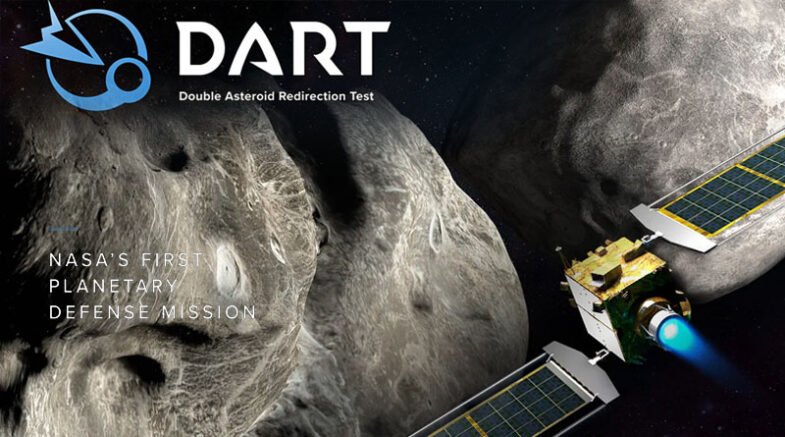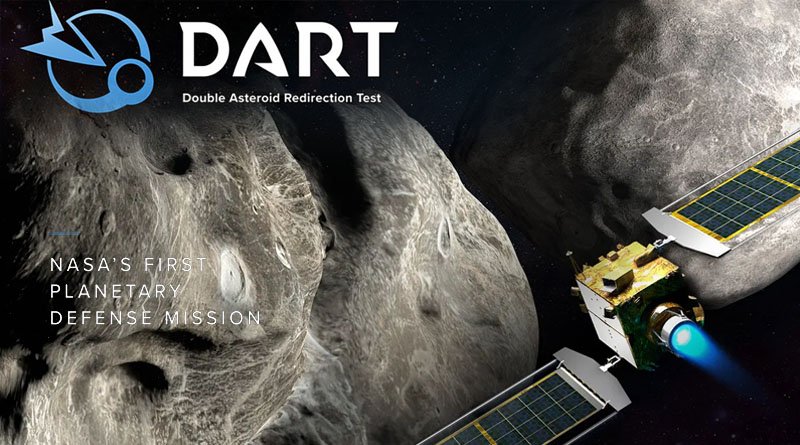Astronomers claim that DART has successfully done both mission, demonstrating that a “kinetic impactor” like DART is a “viable technique to potentially defend Earth if necessary.

The Double Asteroid Redirection Test (DART) mission of NASA had two main objectives: to show that an asteroid could be targeted in a high-speed encounter and to show that the target’s orbit could be changed.
Astronomers claim that DART of NASA has successfully done both mission, demonstrating that a “kinetic impactor” like DART is a “viable technique to potentially defend Earth if necessary.” Two studies are part of a group of five DART papers published online in the journal Nature on March 1st.
The most recent findings concentrate on reconstructing DART’s final moments, making exact calculations of how much the spacecraft altered its target’s orbit, solving the mystery of Dimorphos’ twin tails, and highlighting significant mission moments recorded by an international network of citizen science telescopes.
Even though scientists are still analysing the DART data, they are already planning a follow-up mission: the Hera spacecraft from the European Space Agency, which will launch in October 2024 and arrive at Didymos two years later.
Hera is tasked with thoroughly investigating the Didymos-Dimorphos system, including the crater left by DART’s plunge. “This situation is exciting and rare for planetary exploration.” Co-author of one of the studies and planetary scientist at The Johns Hopkins University Applied Physics Laboratory (APL), Carolyn Ernst, told Space.com in an email.
The DART probe started sending home images once every five hours, which were then processed by a ground optical navigation team, researchers report in the new papers, a month before its impact.
The SMART Nav system onboard DART’s autonomous navigation system was given free reign to navigate itself about four hours before impact. This system also processed images to first recognize Didymos and later Dimorphos.
The mission team kept DART of NASA moving towards Didymos until it was able to detect Dimorphos, the smaller and dimmer of the two, which it did 73 minutes prior to slamming into it, according to researchers. They did this because they already knew that Dimorphos would be hidden from the spacecraft’s view for much of this time.
Nobody had ever acquired a resolved image of Dimorphos, so seeing it for the first time was amazing, according to Ernst. According to that image, Dimorphos’ surface was covered in boulders, much like the rubble-pile asteroids Ikotawa, Bennu, or Ryugu.
According to one of the five brand-new studies, the DART probe stopped maneuvering about 2.5 minutes before it crashed in order to calm down and lessen jitter and smear in its final images.
The spacecraft took an image every second during this phase, including one of the Dimorphos patch that would be its impact site. This image was the last one to be sent home, arriving on Earth 1.8 seconds before the planned impact between two large boulders on the asteroid.
DART grazed one of the boulders just before impact because it approached Dimorphos at a 73-degree angle and had slightly slanted solar arrays. Before this mission, scientists were unsure of Dimorphos’ appearance; it might have been anything from a jumble of debris to a single large rock.
The shape of the asteroid was modelled using the DART data using a method known as stereo photo clinometry, which is frequently used to model the shapes of small bodies. They discovered Dimorphos to be an oblate spheroid with a diameter of 580 feet, similar to a rugby ball (177 m).
It’s obvious that it’s a group of rocks! Ernst stated that she was taken aback by how ellipsoidal the asteroid appears. In order to apply this kinetic impact technique for planetary defence, Ernst said her team is working on new models and experiments to better understand what precisely occurred during DART’s impact and how the event changed the asteroid’s orbit and spin.
There are still a ton of things to learn, she declared. Dimorphos’ leading hemisphere, which faces forward as the rock orbits the sun, was struck by DART when it collided with the object as intended. In order to maximise momentum transfer from the spacecraft to the asteroid and help move it closer to Didymos, researchers planned the impact in this way.
Researchers have discovered that when DART slammed into Dimorphos, at least 2.2 million pounds (1 million kilograms) of blasted-out material provided an extra boost of momentum that was crucial in reducing the asteroid’s orbital period by 33 minutes. Andrew Cheng, the lead author of the study, was surprised to find such a large momentum transfer.
DART’s DRACO instrument recorded positions of Didymos and Dimorphos relative to each other as the probe approached the asteroid system, and the team calculated the 33-minute change in Dimorphos’ orbit despite the presence of ejecta. The team also found that DART’s crash did not change Didymos’ orbital period around the asteroid duo’s center of mass, which is still 2.26 hours.
This test is the first and so far the only one that shows we can use kinetic impactors like DART to deflect asteroids. Researchers observed the ejected debris from the moment DART crashed into Dimorphos for 18.5 days, beginning 15 minutes after the impact. The ejected material morphed into a cone-like shape with rock clumps of various sizes flying as far as 310 miles (500 km) from the asteroid.
Three hours after the collision, a dust tail emerged in a direction opposite to the ejecta cone, and radiation from the sun stretched it more than 930 miles (1,500 km).
A second tail formed between Oct. 2 and Oct. 5, and the increase in scattered dust decreased the Didymos system’s overall brightness. The team tracked the tail until it faded away two and a half weeks later. While astronomers know of a few asteroids with twin tails, they had not expected Dimorphos to flaunt them.
Jian-Yang Li, an astronomer at the Planetary Science Institute in Tucson, Arizona, and the study’s lead author, believes the double tail formed by a few blasted rocks re-impacting Dimorphos or Didymos, or larger rocks colliding and disintegrating into small pieces.
The smaller ejected particles will likely hover in the Didymos-Dimorphos system for a few months, while the larger ones could be around for even longer as long as they don’t hit either Didymos or Dimorphos.
The DART mission of NASA was one of the few relying on ground-based observations for its success, but there were few places on Earth where the Didymos system was visible at the moment of DART’s crash. Astronomers were unable to use their best telescopes to watch it, as they were not in the right place at the right time.
Astronomers also worried that Dimorphos would move too fast for Hubble or the James Webb Space Telescope to capture good images. Luckily, both telescopes worked in sync and recorded valuable data, but their observations were delayed by at least 15 minutes and did not include images at the time of impact.
Citizen astronomers in Reunion Island and Nairobi, Kenya used the Unistellar eVscope to observe the Didymos system during DART’s crash. They estimated the mass of the dust cloud to be 0.3% to 0.5% that of Dimorphos, and found that the impact spiked the system’s brightness to a magnitude of 2.29, or nearly 10 times.
The asteroid returned to its original brightness a little over two weeks later, and the study’s findings confirm that Dimorphos is safe and sound, albeit with a lesser mass. This is good, as the goal was to deflect the asteroid, not destroy it.
This study was a collaboration between eight SETI Institute astronomers and many citizen scientists, who voluntarily shared their observations of DART’s impact.
The team noticed that Didymos reddened slightly for a bit shortly after DART’s plunge, which could be due to either our viewing angle or its irradiated material. Researchers saw a similar reddening effect in the thick dust cloud caused by NASA’s Deep Impact spacecraft when it crashed into comet Tempel 1.
The Unistellar citizen astronomers are the driving force behind this work, and upon acceptance of the paper, they all agreed to celebrate with a slice of cheesecake in their respective parts of the world.
